Table of Contents
Sometimes all we need is a little inspiration. That’s why we wanted to put together a list of User Generated Content examples to keep your gears grinding! After all, User Generated Content Marketing is one of the most lucrative ways to increase conversions on your store. So if you haven’t started integrating customer content into your website. Take a look at these User Generated Content examples and discover how UGC galleries can be a game-changing tool for your brand.
User Generated Content refers to any form of content – such as text, images, videos, reviews, or discussions – that is created by individuals rather than brands or organisations. This content is voluntarily produced by users on various online platforms, including social media, forums, blogs, and review sites. UGC is valuable for its authenticity, diversity, and ability to engage audiences, often serving as a powerful tool for building communities and driving marketing efforts.
A UGC gallery is simply a picture gallery that is auto-populated with images submitted by your customers, which can be housed on your website – on your homepage or a specific product page for instance.
Not only are User Generated Content galleries appealing to the eye, but their presence also gives customers a sense of comfort before buying an item (especially a high-priced one), as they get to see real people using the product in different ways. Plus, they can help you increase your conversion rate. For example, watch brand CLUSE saw a 19% increase in conversions when they added a gallery to their site via our UGC platform.
Most stock photos are filled with models who often appear fake and staged. However, a UGC gallery showcases images of customers who are beyond happy with their products in real life. If you haven’t embedded a User Generated Content gallery into your website, what are you waiting for? Flowbox is the perfect solution for this.
Let’s take a look at some User Generated Content examples, namely how some eCommerce stores have incorporated UGC galleries into their websites.
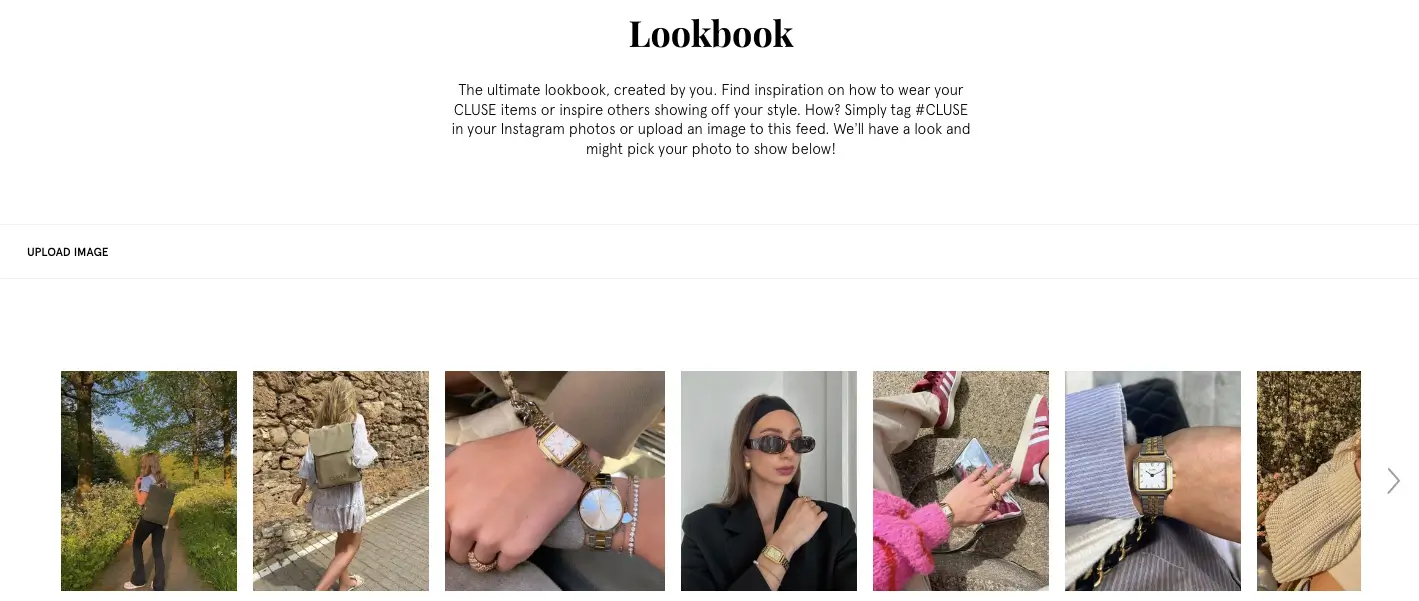
First up on our list – Cluse Watches, which uses a carousel style UGC gallery to populate their “Lookbook” section. Shoppers can scroll through the pictures to see how Cluse’s customers have paired their watches with their outfits, and the beauty of this is…

…upon clicking into a specific picture, there’s a direct link to the featured watch, making it extremely easy for the viewer to shop the look!
Ready to enhance your website’s engagement by implementing UGC like the brands featured in this article? Book a demo with Flowbox today!
Vera Wang Bride is a highly popular bridal fashion company owned by the group Pronovias. The iconic designer has been dressing brides as well as bridesmaids for years and boasts countless women who said ‘yes’ to the dress.
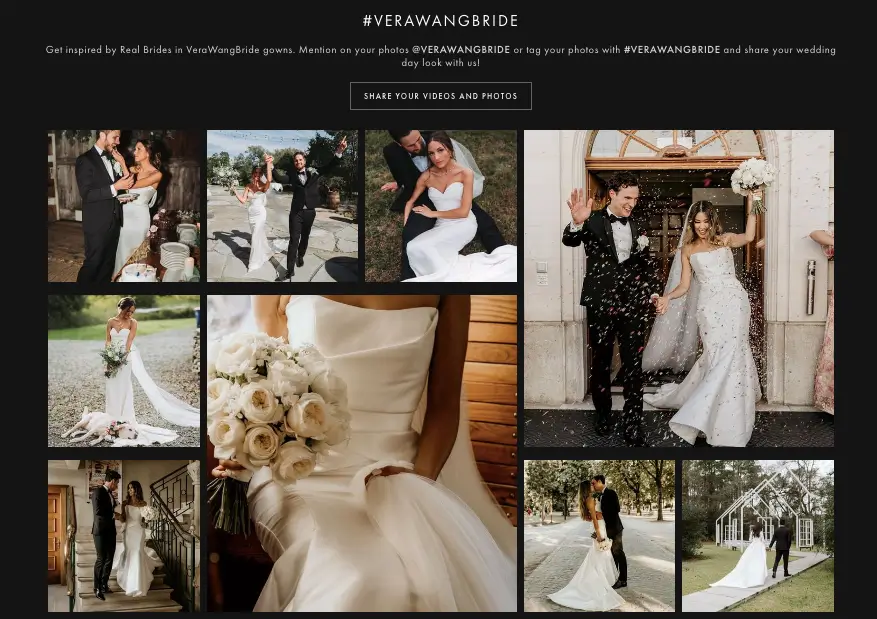
Your wedding dress is not an easy purchase to make, therefore implementing UGC was a revolutionary move for the brand, as it provides proof that Vera Wang Bride is a safe choice for your special day.
UGC can also be leveraged by not only industries that sell specific products but also those that sell experiences. The West Frisian islands boast stunning sand dunes and widespread beaches, verified by the very holidaymakers that go there.
Leisure and tourism company, VVV Ameland reaps the benefits of UGC by embedding Instagram feeds of their visitors who post pictures of beautiful sights during their holidays on the island.
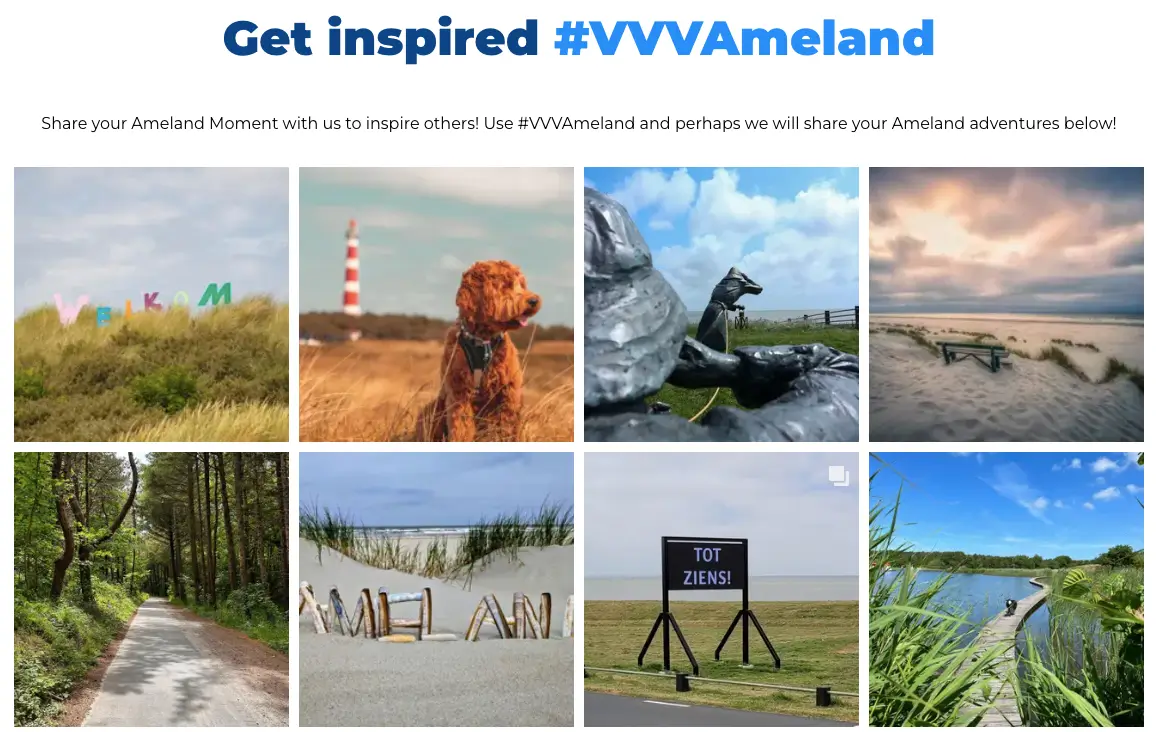
This User Generated Content example features a stylish UGC gallery that matches the look and feel of this popular Dutch getaway. Adding a User Generated Content gallery to the site gives prospective visitors the opportunity to get a real feel of the location and push them to book their holidays there.
Alfa sells quality footwear, covering disciplines such as hiking, hunting and cross-country skiing. Alfa is one of Norway’s oldest footwear brands, but is moving with the times and has chosen to incorporate UGC in its content marketing strategies.
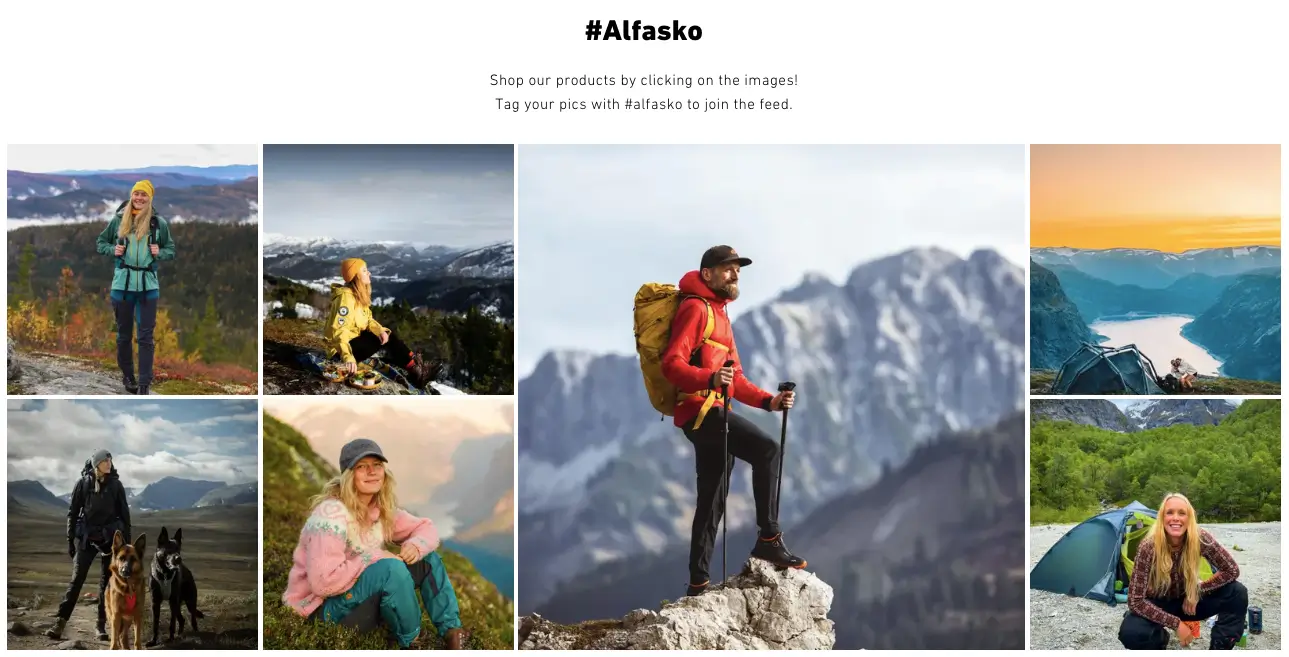
As many other sporting goods brands will testify, the addition of social proof is paramount to the shopper, as the sports kit is verified in action – the consumer needs to see how the product performs in the activities they are destined for.
Salsa Jeans focus on providing high-quality customer content for shoppers in the eCommerce Lookbook. Founded in 1994 in a small town in Portugal, the brand sells premium Portuguese fashion to a devoted base of customers.
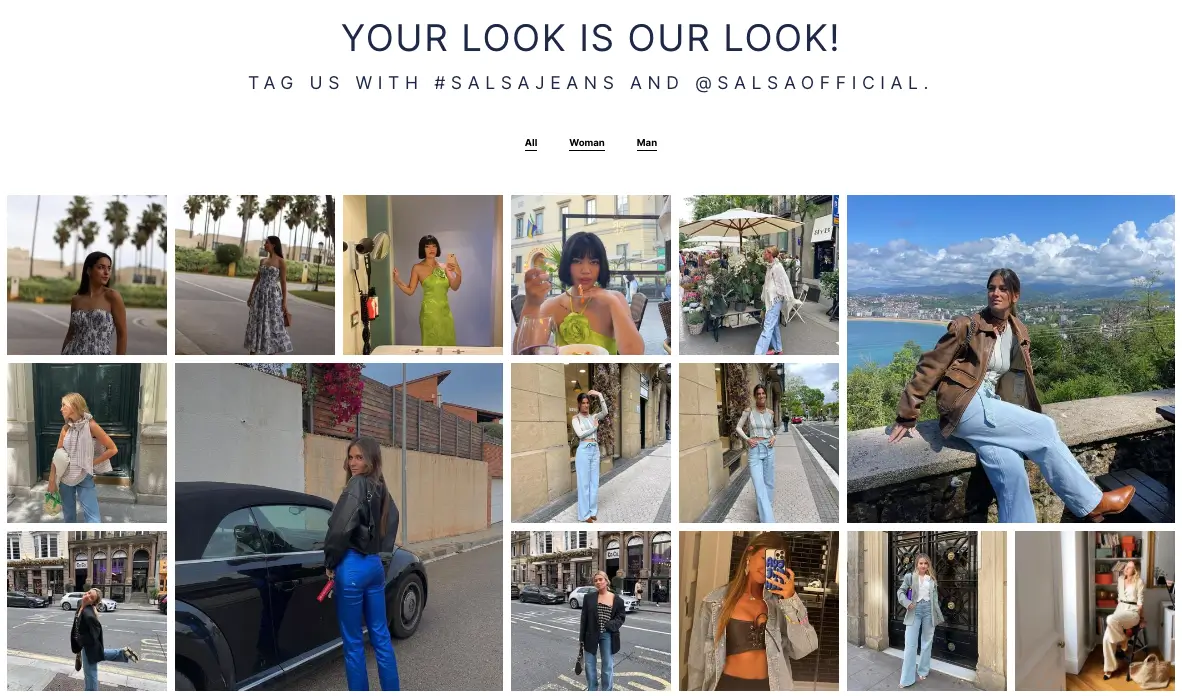
Now customers can be endlessly inspired by User Generated Content examples on Salsa Jeans feed. Plus, their gallery is completely shoppable, giving consumers the optimum eCommerce experience.
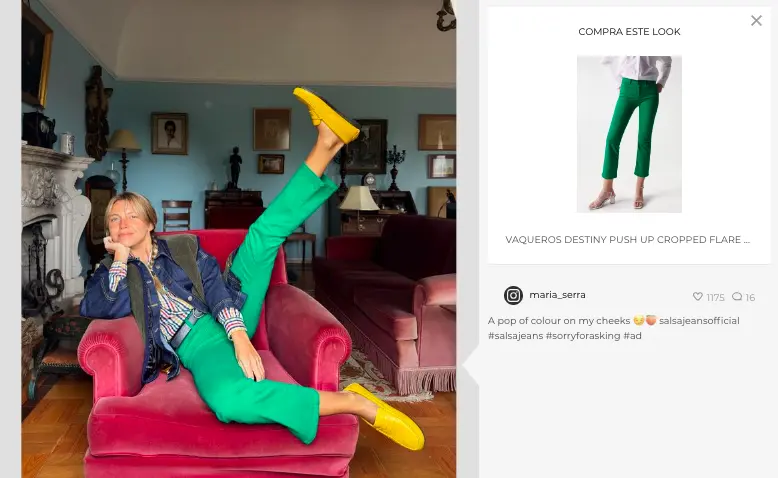
Showing off their products to real customers gives potential customers a sense of satisfaction. They’ll be able to visualise what the product might look like on them, which helps people determine whether or not they want to purchase the product.
The UGC potential never ends! It’s clear to see how well their UGC gallery integrates into the brand’s style. One glance, and you can see why customer content is an eCommerce must-have.
Boob Design is known for its fashionable and convenient maternity clothing. The brand was founded by Mia Seipel in 1999 who discovered a lack of appropriate fashion for mothers whilst witnessing her sister having to breastfeed her newborn without the proper nursing apparel.

The store caters to mums to be of all stages and counts on User Generated Content examples to show women that their maternity clothing can actually fit them well. We definitely recommend following Boob Design’s lead when it comes to User Generated Content. Trending and seasonal items will sell better, especially if customers are able to see how the outfits look on real mothers!
Another great example of an eCommerce UGC gallery is the one by Śnieżka, a Polish decor brand that specialises in paint.
By having a UGC gallery that showcases various interiors painted using the brand’s paint, the brand brings an incredible amount of diversity to the table. Shoppers are able to digitally swatch different colours before making the giant decision of which one to choose for their interior – a decision we all know can be extremely tough.

Given that paint colours on a screen can be distorted, as well as look different once painted on a wall, Śnieżka photo gallery featuring the various colours in the brand’s catalogue allows potential customers to better visualise their interior.
With such a saturated market that is the cosmetics industry, brands nowadays have to be special to stand out and attract shoppers. This is where UGC plays a crucial role. Resellers such as Maquillalia are competing with other eCommerce operations that may also be selling the same products.
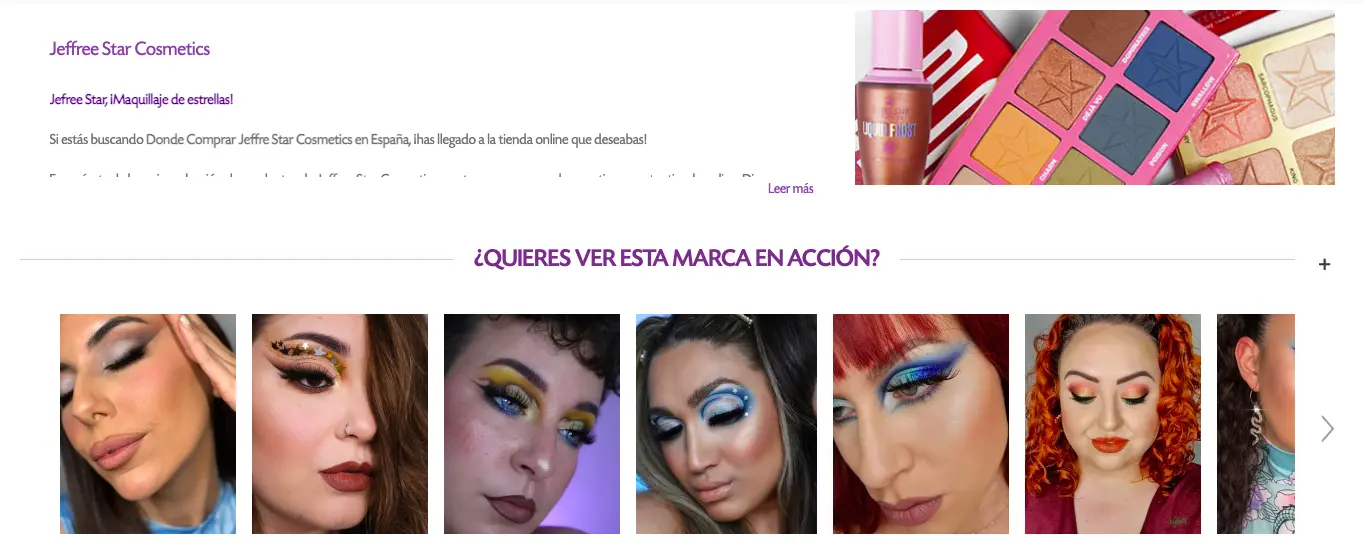
With an innovative marketing strategy that is founded on UGC and customer photos implemented throughout the whole site, this makeup brand adds a personal touch, where shoppers are advised and inspired by the looks they can create with these products.
The Spanish brand takes it one step further, and incorporates product UGC galleries, meaning shoppers are able to see filtered content, tailored to the brand they are browsing at the given time. Maquillalia seduces with a user-friendly interface, boosting sales and increasing conversion rate, all the while creating a sense of community.
Dutch garden brand Weltevree jumped on the UGC bandwagon in 2020 and currently features UGC galleries on their homepage, as well as their community and product pages. Thanks to Weltevree’s User Generated Content examples, plant parents around the world are able to put their green thumbs to good use with a UGC enhanced shopping journey.
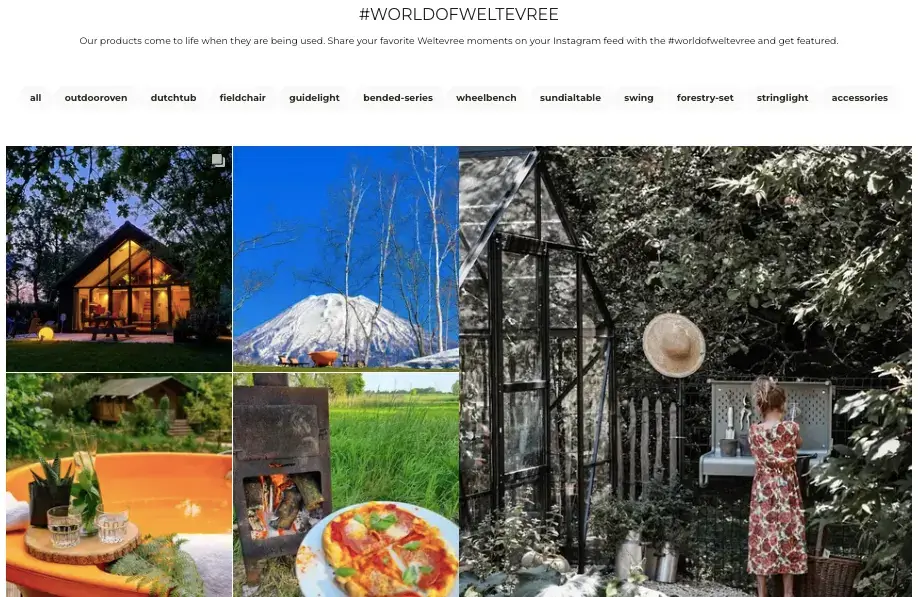
Weltevree also includes filters on its community page, allowing users to sift through all the content to find inspiration tailored to their needs – with a vast catalogue which includes various different types of products, it is important for brands to be able to offer their customers the possibility to narrow down their search and match their website to their needs.
Have you ever wanted to completely redesign your living room but could not quite find the perfect piece of furniture? Just take a scroll through ScS’ User Generated Content examples, and you’ll be hankering to redecorate your entire house. With high-ticket items such as furniture, turning browsers into shoppers can be a challenging task.
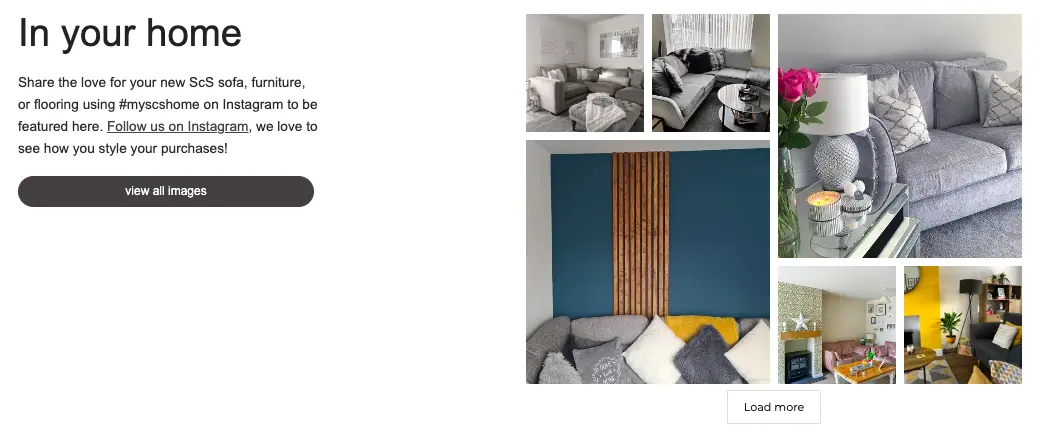
This is where UGC has helped ScS provide the inspiration needed to make the purchase. Their stylish galleries show their customers’ photos of ScS sofas in their homes, giving an intimate touch to the shopping journey as users can see the items in different interiors that may correspond to their own.
Health is wealth! And nothing inspires a healthy lifestyle quite like a sense of community. As difficult as navigating the health and wellness industry can seem, Naturitas is offering a helping hand by featuring UGC on their website to guide you in this journey and boy oh boy, does their gallery look amazing.
From natural supplements to fresh produce and organic cosmetics, Naturitas promotes a mindful and healthy lifestyle, alongside an army of inspiring customers. Not every UGC gallery has to feature makeup, clothes, and accessories after all. People love to see pictures of clever snack ideas or recipes, and if you’re lucky, they may stop at the store on their way home to pick up your product!
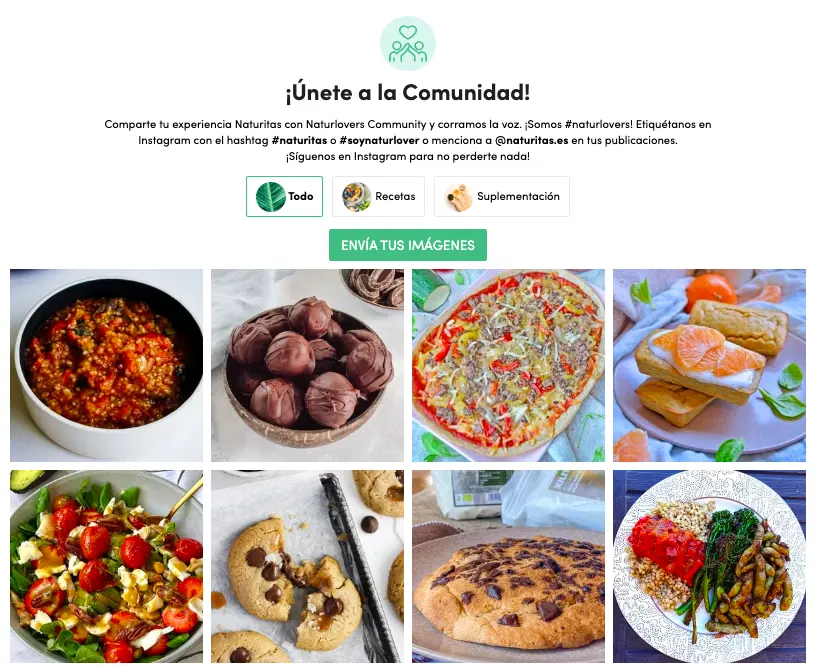
Naturitas’ User Generated Content integrations are a great example of how consumer content can add value across multiple different areas of an eCommerce website.
There are UGC galleries on their homepage, product pages, category pages and on a dedicated lookbook-style community page that allows users to filter between User Generated Content examples of recipes, and supplements, or see all content categories at once.
Some products are more difficult than others to sell online. For example, cameras are not so much about what the product looks like, but rather the images it produces. What better way to validate this than by implementing UGC of professional photographers and photography aficionados? Casanova Foto uses a UGC gallery to provide examples of the stunning images these cameras can capture.
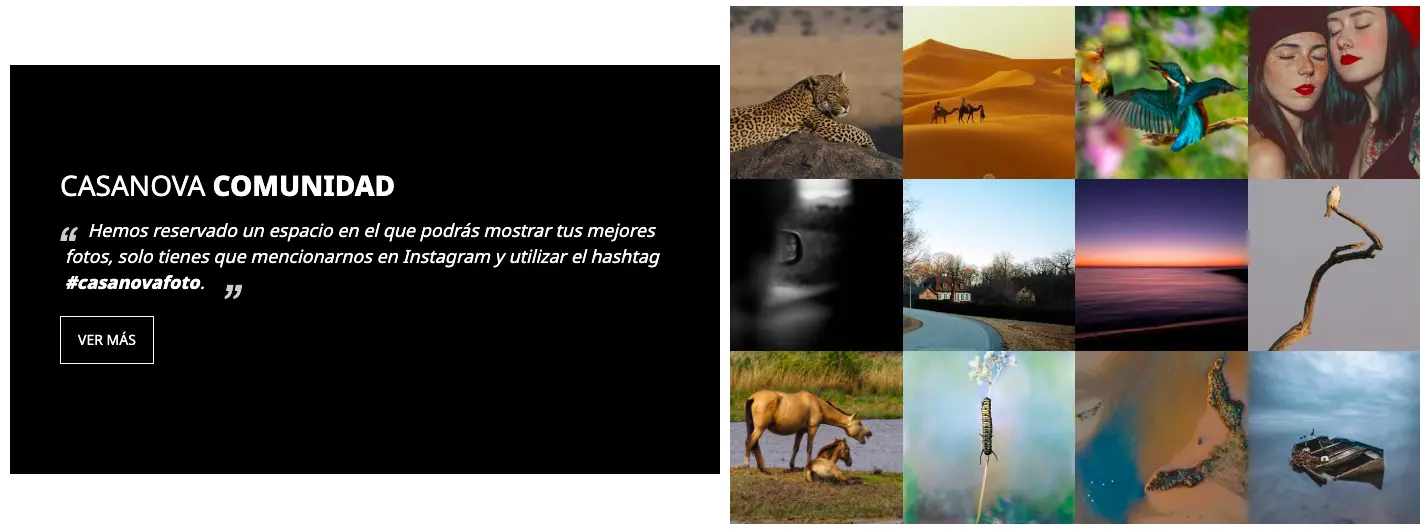
In a way, implementing UGC on their website creates an artist space, which allows the community to exchange their work and help guide a well-informed purchase.
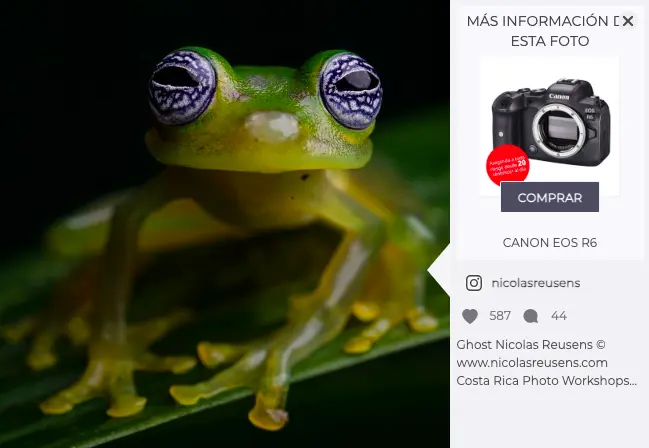
In 2020, Hunkemöller made the strategic decision to integrate User Generated Content (UGC) into their eCommerce journey through the use of Flowbox. As a result, their website now boasts an extensive array of UGC, which has notably contributed to increased sales among their shoppers.
Upon visiting the website, users are greeted with captivating “Flows” displayed prominently on the homepage. These Flows serve as a source of inspiration, showcasing how other women style their lingerie with confidence. Through a commitment to inclusivity, Hunkemöller ensures that every woman feels represented and acknowledged, thereby fostering a positive environment that encourages shoppers to invest in products that have empowered numerous women to feel fantastic about themselves.
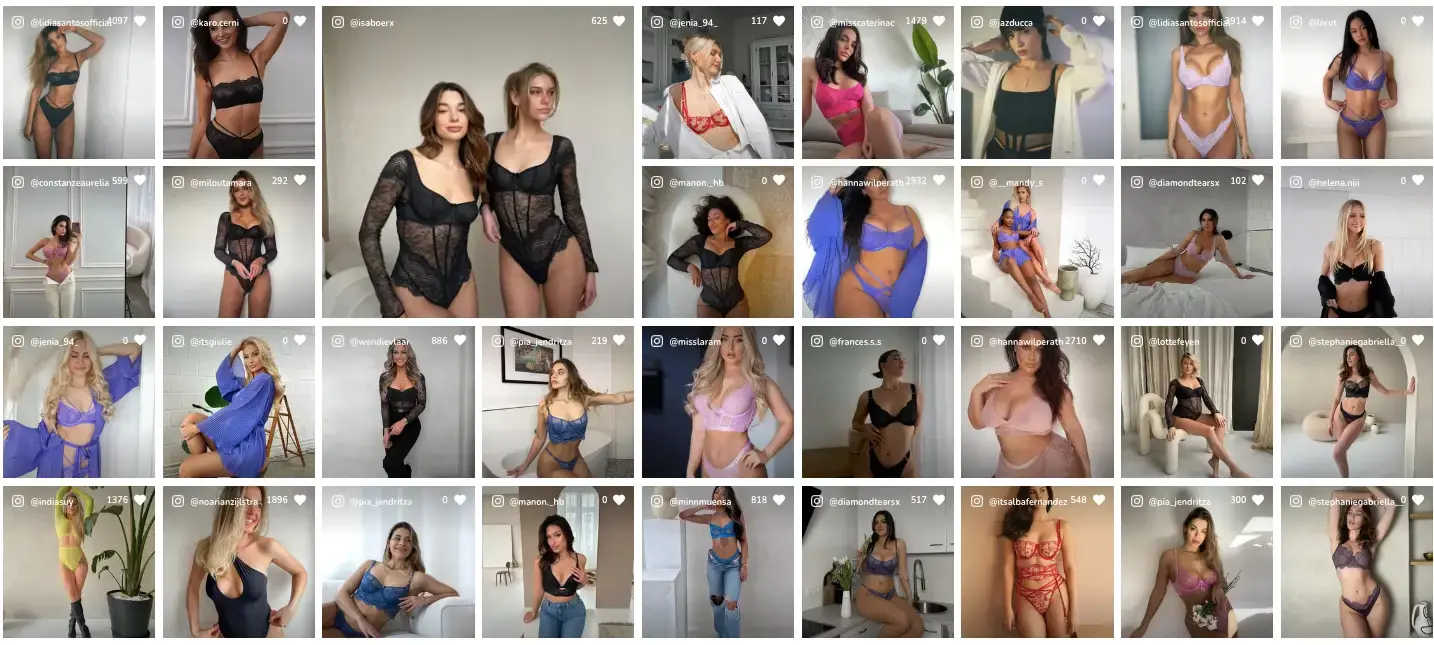
Throughout the online shopping experience, users encounter UGC at every turn, reflecting Hunkemöller’s dedication to celebrating its “Sheroes” and embodying its core values, thus serving as an inspiration to prospective customers. The integration of a vast collection of Instagram content facilitated by the Flowbox platform further enriches the virtual visit, reinforcing the brand’s message and enhancing the overall shopping experience.
Our next example is from Vintage Jewellery. The brand enthusiastically promotes engagement within the Vintage Jewellery community by inviting clients to share their posts on social media. This process is straightforward: clients simply need to tag the brand and upload a picture using the specified hashtag #continuethestory.

What distinguishes Vintage Jewellery from other brands is its unique method of content acquisition. They not only gather content directly from clients’ social media profiles but also provide customers with the option to upload their pictures through the ‘upload your media’ button.
The Swedish brand ICIW stands out as one of the premier sportswear companies in Scandinavia. ICANIWILL features a striking Insta Shop Flow on their website, seamlessly integrating captivating UGC curated by Flowbox into their product catalogue.
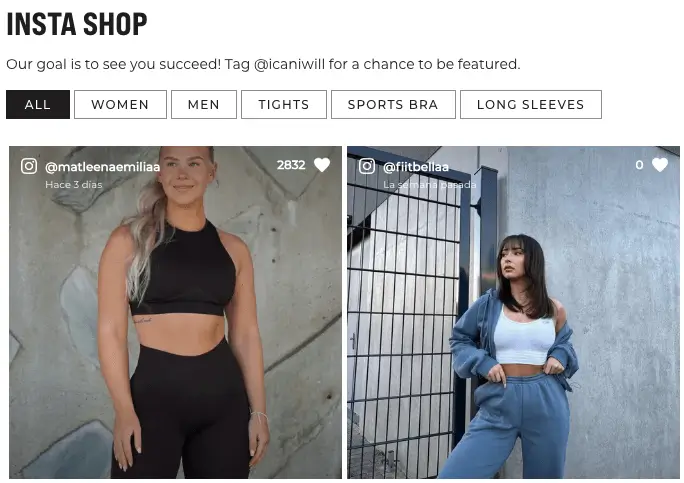
With a significant number of consumers relying on social media for their purchasing decisions, it’s clear that incorporating a User Generated Content gallery is a strategic and beneficial move. ICIW utilizes various tags to assist users in effortlessly locating their desired items.
Now an example from the sporting world: BSC Young Boys.
User Generated Content has been seamlessly incorporated into the homepage of their fanshop, where visitors encounter a dynamic collage of images showcasing both players and fans donning the official kit, as well as various apparel items like hoodies, beanies, scarves, and more.

Clicking on specific User Generated Content directs users to the linked products, streamlining the purchasing process of BSC Young Boys. Additionally, their fanshop presents an aesthetically pleasing dedicated #YBFamily inspiration page, featuring filtering buttons that allow visitors to sort User Generated Content by different categories such as Men’s, Women’s, kids, and accessories, enabling potential customers to refine their inspiration based on their preferences.
Now that you’ve seen all of these great User Generated Content examples, let’s discuss setting up your UGC gallery.
The easiest way of doing this is simply to use a UGC platform such as Flowbox. Here’s how it works. Depending on your specific settings, pictures that are either hashtagged with your unique hashtag or uploaded to a certain account will be “collected” into a dashboard. This is done across various social media channels including but not limited to Facebook, Instagram, and Twitter.
On your end, you can then curate and approve the specific pictures which will then appear on your feed. When customers click on a picture in the gallery, they’ll be able to view the “Shop This Look” product recommendation function.
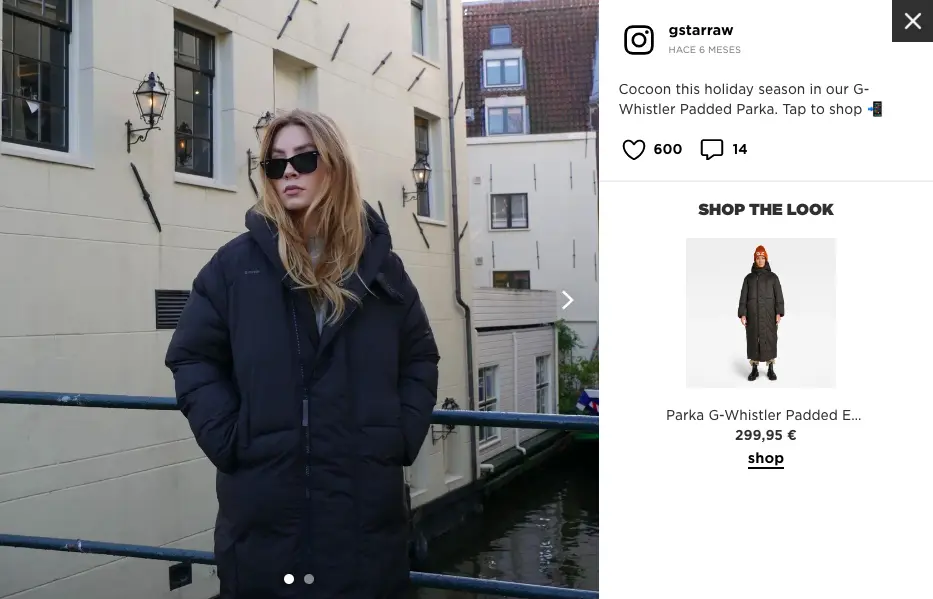
And your website has just undergone the ultimate upgrade! Track how well User Generated Content works for your brand using Flowbox analytics – you’ll thank us when you see that conversion rate increasing.
Flowbox’s platform allows brands to gather, curate, moderate, share and analyze highly valuable User Generated Content – leading them to make more conversions and build strong customer relationships.
Now that you’ve made it all the way to the end of the article, I hope you’ll find it clear that User Generated Content galleries aren’t a “nice to have” for eCommerce store owners – they’re a “must have”. These were just a few User Generated Content examples, but there are tons out there!
It’s easy to get complacent after you’ve gotten all your processes in place (and ticked off every item on the checklist that I mentioned at the start of this article). However, the reality of the eCommerce industry is that it’s evolving at a rapid pace and that merchants are, across the board, getting increasingly sophisticated.
Maybe it was sufficient to have an automated email campaign and a mobile-optimized website five years ago. But it’s not anymore. To leap ahead of your competitors and grow your revenue, you need to adopt new technology and strategies – including UGC galleries.
The good news? It’s insanely easy to get started – all you have to do is spend some time (we’re talking less than an hour!) setting up an account on Flowbox or other similar platforms, and they’ll take care of the rest. In no time, you’ll see higher conversion rates, more sales, an increase in revenue, and even fewer returns.
Here’s to making technology work for you, not the other way around. We hope these User Generated Content examples have inspired you to get your own gallery. Have any questions about the process? Don’t hesitate to contact us!
If you want more on UGC, visit our complete guide to User Generated Content strategy.